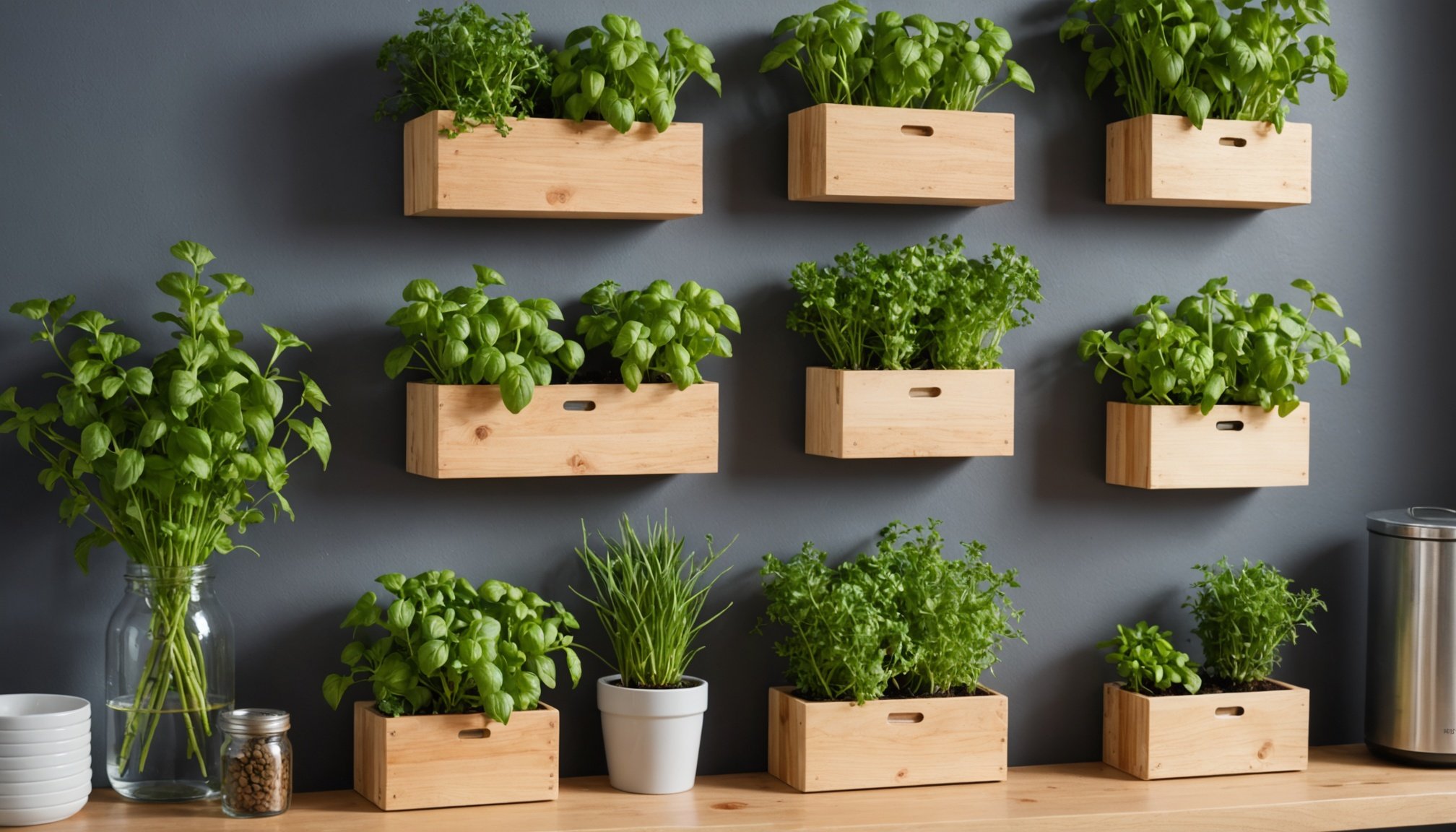Maximizing Space in a Compact Kitchen
When it comes to a space-saving kitchen design, challenges arise primarily due to limited room for storage and cooking activities. Creative solutions become vital in such environments. One highly effective approach is the use of vertical space. This method not only increases functionality but also adds an artistic dimension to your kitchen. Incorporating vertical gardening solutions allows you to cultivate fresh herbs right where you need them most.
By opting for vertical gardening systems, such as wall-mounted planters or tiered shelving, kitchen spaces can be optimized. This vertically-oriented approach provides ample room for growing a variety of herbs without infringing on your already precious counter space.
Have you seen this : Revamp your glasgow loft into a charming reading retreat: innovative ideas for avid bookworms
While purely functional, these solutions do not sideline aesthetics. The importance of aesthetic appeal cannot be overstated, as a visually pleasing herb arrangement can transform a kitchen from purely functional to a place of inspiration and enjoyment. When designed thoughtfully, vertical gardens can become a vibrant centrepiece, blending practicality with beauty.
The benefits of elevating your garden extend beyond space efficiency. Access to fresh herbs enhances flavour in cooking while simultaneously improving air quality and personal well-being. Vertical gardening thus emerges as a win-win in compact kitchen design.
Also to read : Ultimate guide to maintaining your norfolk farmhouse”s charming thatched roof: tips and best practices
Essential Materials for a Vertical Herb Garden
Establishing a vertical herb garden requires a thoughtful selection of materials to ensure success. The first essential component is the choice of containers. Herb planters come in various forms, from wall-mounted pockets to stackable trays, offering flexibility in design and size.
To begin, assemble the basic vertical gardening materials: wall brackets, sturdy containers, and mounting fixtures. Choose containers with adequate space for root growth and ensure they have drainage holes to prevent waterlogging. Good drainage is pivotal in maintaining plant health and preventing root rot.
When selecting soil, opt for a well-draining mix enriched with organic matter for nutrients. This choice supports moisture retention without suffocating the roots. Consider adding perlite or sand to enhance aeration further.
Beyond basic containers, hanging baskets and vertical pallets offer unique herb planter options. Matching these with your kitchen’s decor creates a harmonious and aesthetically pleasing integration.
Lastly, consider your herbs’ unique needs when arranging your setup. Prioritizing accessible sunlight and easy water access will enhance herb growth. By combining the right tools, soil, and container options, your vertical herb garden can flourish, redefining your compact kitchen as a vibrant, green oasis.
Designing Your Vertical Herb Garden
Designing a vertical garden in your kitchen requires creative design concepts that optimize small spaces effectively. Vertical garden design ideas are countless, ranging from simple stacked containers to elaborate wall gardens with integrated irrigation systems. To innovate, focus on balancing functionality with an aesthetic appeal that complements your kitchen decor.
The kitchen herb garden layout should consider proximity to sunlight, as most herbs thrive in light-rich environments. Position your garden in a spot that receives ample natural light, ideally near a window or under a skylight. Water accessibility is another crucial factor; placing your vertical setup close to a water source eases maintenance.
Integrating herb gardens into your decor not only maximizes space usage but also enhances the visual appeal of the room. Consider matching the colour and style of your herb planters with the existing kitchen theme. This seamless integration not only boosts the overall aesthetic but also makes your space-saving kitchen design more harmonious.
Incorporating these elements ensures a productive and visually pleasing vertical herb garden, transforming your kitchen into an oasis of freshness and creativity. Ultimately, thoughtful vertical gardening solutions bring functionality and charm to even the tightest kitchen spaces.
Step-by-Step Planting Techniques
Planting your herb garden vertically presents unique challenges and opportunities. Using the right herb planting methods is key to success. Start the germination process with reliable seeds suited for vertical gardening. Parsley, basil, and mint are popular choices due to their adaptability.
Once seeds germinate, ensure your seedlings receive ample light, ideally placing them near a window where they can thrive. Vertical gardening techniques involve strategically arranging plants to ensure each receives sunlight. Consider using tiered trays or wall pockets to maximize exposure.
Companion planting enhances growth by pairing herbs with complementary needs. For instance, basil can flourish alongside tomatoes, improving their growth while keeping pests at bay. Similarly, parsley and chives make productive neighbours.
Ensure containers have proper drainage to prevent water accumulation which could harm your plants. Incorporating pebbles or netting can help maintain an effective drainage system. Rotate plants periodically to balance light exposure and support uniform growth.
These techniques improve both the success of your garden and the efficiency of your space. Whether you’re a novice or an expert, understanding these vertical gardening techniques ensures a thriving herb garden in any kitchen environment.
Maintenance Tips for a Thriving Herb Garden
Maintaining a successful herb garden requires careful attention to vertical garden care tips for irrigation, pruning, and pest management. Consistent irrigation practices ensure that your herbs receive the right amount of water without over-saturating the soil. Consider using a drip irrigation system or self-watering planters to maintain efficiency. Water deeply but less frequently to encourage root depth and resilience.
Pruning herbs enhances their growth by promoting bushier plants and increasing flavour concentration. Regularly trim your herbs to prevent legginess and to encourage new growth, especially for herbs like basil and mint. Effective pruning also involves removing any dead or yellowing leaves.
Managing pests is crucial for maintaining plant health. Utilise natural remedies such as neem oil or insecticidal soap to protect your garden without harmful chemicals. Companion planting is another effective defence; for instance, planting basil beside tomatoes can ward off unwanted insects.
Incorporating these herb garden maintenance strategies guarantees a thriving, lush garden. Regular care not only optimises plant health but also maximises the flavourful yield of your herb collection, ensuring ongoing culinary enjoyment and a sense of achievement in your kitchen pursuits.
Understanding Regional Climate Considerations
In Sheffield, the local climate shapes regional herb growth conditions, influencing how herbs thrive. Understanding these conditions is vital for any aspiring gardener. Sheffield experiences a temperate maritime climate with mild summers and cool, wet winters. This variability affects the seasonal planting schedules necessary for a successful herb garden.
Sheffield gardening tips recommend planting herbs like parsley and chives early in spring when the risk of frost diminishes. Late spring nurtures basil and thyme perfectly. Utilizing microclimates within your kitchen environment can further enhance growth. Position herbs near windows to capitalize on available sunlight, creating warm pockets conducive to growth. Kitchen windows are often optimal spots, maximizing natural heat and light.
Compensate for Sheffield’s cooler climate by considering indoor lighting solutions. LED grow lights can extend the growing season, ensuring herbs receive the light they need year-round. This proactive strategy means fresh herbs can flourish despite seasonal variations. Additionally, maintaining moderate humidity levels can mitigate indoor winter dryness, encouraging robust plant health.
By understanding and adapting to regional climate conditions, thriving herb gardens are achievable even in compact kitchen spaces. These strategies foster an environment where fresh, home-grown herbs can consistently be at your fingertips.
Visuals and Estimated Costs
Creating a visually appealing vertical herb garden need not be costly. By examining a few inspiring examples, you can visualize how to transform your kitchen space. A simple DIY approach can lead to eye-catching designs using affordable materials.
Costs Breakdown
Understanding the DIY herb garden costs is crucial. Materials like vertical gardening solutions could entail:
- Containers: Invest in wall-mounted planters or tiered shelves for around £20-£50 per set.
- Wall brackets and mounting fixtures: Essential for supporting structures, costing between £10-£30.
- Soil and seeds: Expect to spend approximately £10-£20 depending on quality and quantity.
While the initial investment might seem substantial, the benefits and savings quickly outweigh the costs. Home-grown herbs are fresher, more aromatic, and can reduce grocery bills over time. Furthermore, the herb garden benefits extend beyond culinary uses, contributing positively to air quality and adding an aesthetic charm to your kitchen.
A well-crafted vertical garden not only enhances your space-saving kitchen design but also provides ongoing satisfaction and savings. Incorporate creativity and practicality in your setup, and enjoy the numerous gains of this eco-friendly endeavor.
Benefits of Growing Herbs Vertically
Growing herbs vertically brings multiple advantages to your space, especially in a compact kitchen setting. This approach offers immediate access to fresh herbs right where you cook, enhancing every meal with vibrant flavours. Imagine grabbing a sprig of parsley or a leaf of basil from your wall-mounted garden while preparing dinner—for many, it’s the epitome of culinary convenience.
Environmental Advantages
Vertical gardening is not just about convenience; it also offers notable environmental benefits. By growing your herbs indoors, you reduce your reliance on store-bought produce, thus lowering your carbon footprint. Local cultivation minimises transport emissions, while sustainable practices help conserve resources. A home garden also supports biodiversity by attracting beneficial insects, fostering a balanced micro-ecosystem.
Aesthetic and Air Quality Enhancements
In addition to its environmental perks, a vertical garden significantly improves air quality in your kitchen. Plants naturally filter toxins, thus freshening indoor air. Moreover, cultivating a green space adds aesthetic value, turning your kitchen into a visually appealing sanctuary. The cascading greenery can transform your kitchen into a haven of tranquility and creativity, inspiring both cooking and relaxation.





